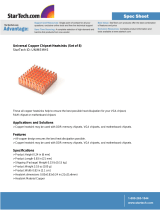
12 Intel
®
Pentium
®
4 Processor on 0.13 Micron Process Datasheet
Introduction
• Processor core — Pentium 4 processor with 512-KB L2 cache on 0.13 micron process core
die with integrated L2 cache and the Pentium 4 processor Extreme Edition supporting Hyper-
Threading Technology core die with integrated L2 and L3 caches.
• FC-PGA2 package — Flip-Chip Pin Grid Array package with 50-mil pin pitch and integrated
heat spreader.
• mPGA478B socket — Surface mount, 478 pin, Zero Insertion Force (ZIF) socket with 50-mil
pin pitch. The socket mates the processor to the system board.
• Integrated heat spreader — The surface used to make contact between a heatsink or other
thermal solution and the processor. Integrated heat spreader is abbreviated IHS.
• Retention mechanism — The structure mounted on the system board that provides support
and retention of the processor heatsink.
1.2 References
Material and concepts available in the following documents may be beneficial when reading this
document.
Table 1-1. References (Sheet 1 of 2)
Document Location
Intel
®
875P Chipset Platform Design Guide
http://developer.intel.com/design/
chipsets/designex/252527.htm
Intel
®
865G/865PE/865P Chipset Platform Design Guide
http://developer.intel.com/design/
chipsets/designex/252518.htm
Intel
®
Pentium
®
4 Processor in the 478-Pin Package /
Intel
®
850 Chipset Platform Family Design Guide
http://developer.intel.com/design/
pentium4/guides/249888.htm
Intel
®
Pentium
®
4 Processor in the 478-Pin Package and
Intel
®
845 Chipset Platform for DDR Platform Design Guide
http://developer.intel.com/design/
chipsets/designex/298605.htm
Intel
®
Pentium
®
4 Processor in the 478-Pin Package and
Intel
®
845E Chipset Platform for DDR Platform Design Guide
http://developer.intel.com/design/
chipsets/designex/298652.htm
Intel
®
Pentium
®
4 Processor in the 478-Pin Package and
Intel
®
845 Chipset Platform for SDR Platform Design Guide
http://developer.intel.com/design/
chipsets/designex/298354.htm
Intel
®
Pentium
®
4 Processor in the 478-Pin Package and
Intel
®
845GE/845PE Chipset Platform Design Guide
http://developer.intel.com/design/
chipsets/designex/251925.htm
Intel
®
Pentium
®
4 Processor in 478-pin Package and
Intel
®
845G/845GL/845GV Chipset Platform Design Guide
http://developer.intel.com/design/
chipsets/designex/298654.htm
Intel
®
Pentium
®
4 Processor with 512-KB L2 Cache on 0.13 Micron
Process Thermal Design Guidelines
http://developer.intel.com/design/
pentium4/guides/252161.htm
Mechanical Enabling for the Intel
®
Pentium
®
4 Processor in the 478-pin
Package
http://developer.intel.com/design/
pentium4/guides/290728.htm
Assembling Intel Reference Components for the Intel
®
Pentium
®
4
Processor in the 478-pin Package
http://developer.intel.com/design/
pentium4/guides/298590.htm
Voltage Regulator-Down (VRD) 10.0: for Desktop Socket 478 Design
Guide
http://developer.intel.com/design/
pentium4/guides/252885.htm
Voltage Regulator Module (VRM) 9.0 DC-DC Converter Design
Guidelines
http://developer.intel.com/design/
pentium4/guides/249205.htm
Intel
®
Pentium
®
4 Processor VR-Down Design Guidelines
http://developer.intel.com/design/
Pentium4/guides/249891.htm
CK00 Clock Synthesizer/Driver Design Guidelines
http://developer.intel.com/design/
pentium4/guides/249206.htm
Intel
®
Pentium
®
4 Processor 478-Pin Socket (mPGA478B) Socket Design
Guidelines
http://developer.intel.com/design/
pentium4/guides/249890.htm




















